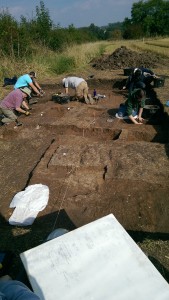Feed URL: https://blogs.kent.ac.uk/digthewolds/2014/09/26/26914-the-final-stages/feed/?withoutcomments=1
Being the last days on site for much of the team, including the undergraduates, the main focus on site has switched from excavation to the recording of any features.
One of the most important elements of the record is the site plan. The site plan is crucial as not only does it record the individual features in the trench but it also helps show the relationship between the different features. By setting out a basic grid plan within the trench, key points can be mapped out on a sheet of permatrace over graph paper, much like with the profile and section drawings, and the features drawn in this enables a great level of detail to be precisely recorded. While the profile and section drawings are drawn at a scale of 1:10 the size of the trench means that it is drawn at a scale if 1:20 instead; this is a normal convention for site plans.
While many of the features are recorded through the profile and section drawings and the site plan some features also call for soil samples to be taken. At Hatcliffe the features that were selected for soil samples are thought potentially to be corn dryers and it is not surprising that they had a high carbon content from burnt material including clay. These samples will now be sent to a specialist who will carefully sift out any inclusions in the soil and analyse what is found to see if the corn dryers can be more exactly dated and their function determined as we are only working on an assumption that they are likely corn dryers . Inclusions in the soil such as bones from small animals can be crucial as animals such as a house mouse could indicate the presence of settlements in the area and therefore could add to our knowledge and interpretation of the site.
The time both at Hatcliffe and Binbrook has been an incredibly important learning curve for the undergraduates who have been able to improve their knowledge of Archaeological practice greatly.

